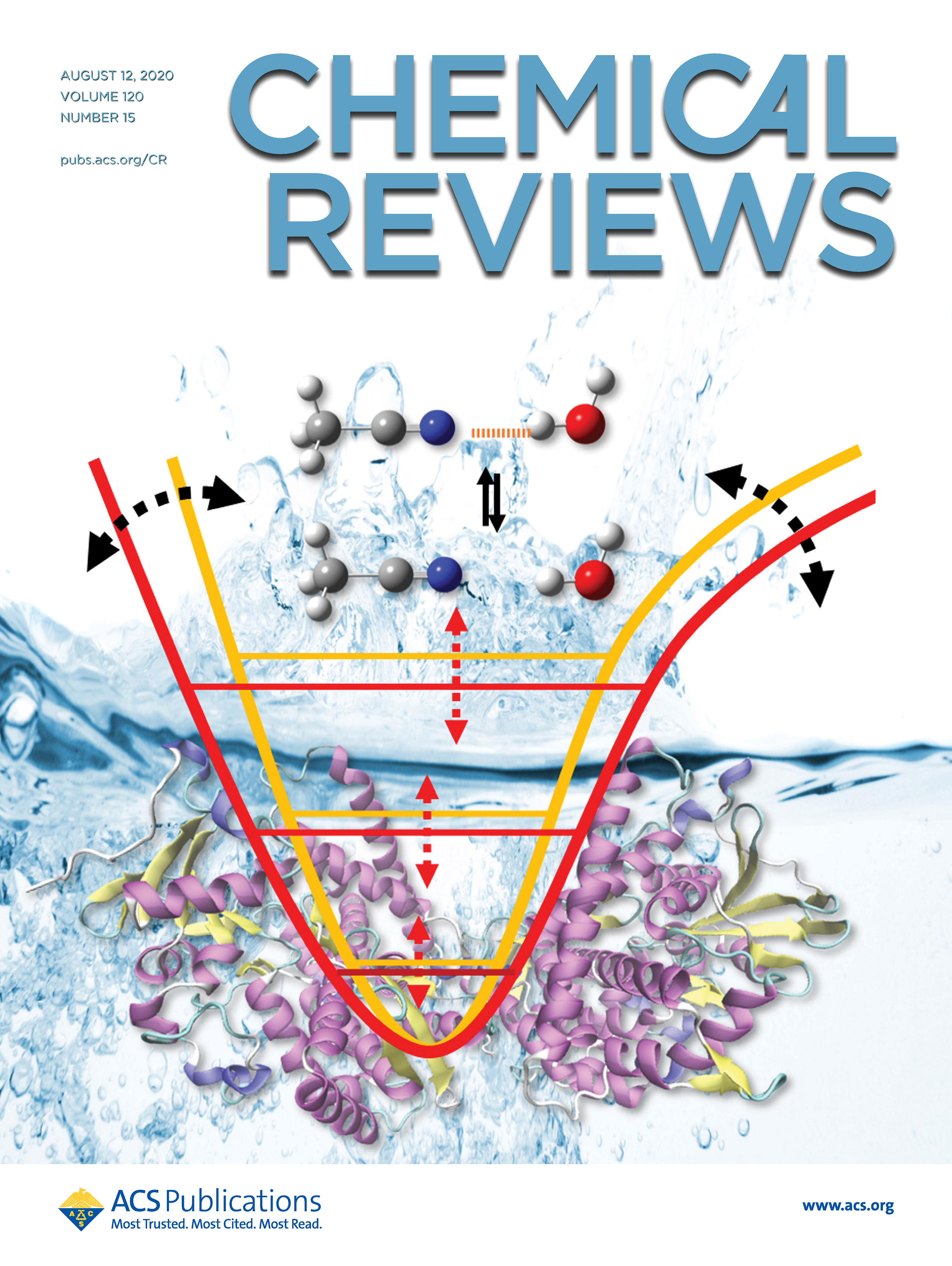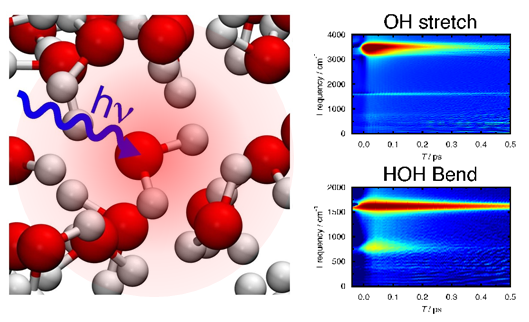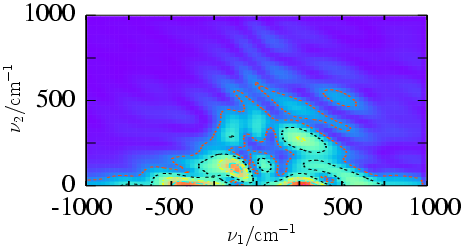| Multi-dimensinal spectroscopies of liquids |
We have investigated detailed dynamics, in particular intermolecular dynamics, in condensed phases in terms of multi-dimensional spectroscopies.
Two-dimensional infrared spectroscopy
Review
C. R. Baiz et al., Chem. Rev. 120, 7152-7218 (2020).
 |
Jansen, Saito, Jeon, & Cho, J.Chem.Phys. 150, 100901 (2019) (Perspective) (invited).
T. Yagasaki and S. Saito, Annu. Rev. Phys. Chem. 64, 55-75 (2013) (invited).
Theory of coherent two-dimensional vibrational spectroscopy
Two-dimensional (2D) vibrational spectroscopy has emerged as one of the most important experimental techniques useful to study the molecular structure and dynamics in condensed phases. Theory and computation have also played essential and integral roles in its development through the nonlinear optical response theory and computational methods such as molecular dynamics (MD) simulations and electronic structure calculations. In this article, we present the fundamental theory of coherent 2D vibrational spectroscopy and describe computational approaches to simulate the 2D vibrational spectra. The classical approximation to the quantum mechanical nonlinear response function is invoked from the outset. It is shown that the third-order response function can be evaluated in that classical limit by using equilibrium or non-equilibrium MD simulation trajectories. Another simulation method is based on the assumptions that the molecular vibrations can still be described quantum mechanically and that the relevant molecular response functions are evaluated by the numerical integration of the Schrödinger equation. A few application examples are presented to help the researchers in this and related areas to understand the fundamental principles and to use these methods for their studies with 2D vibrational spectroscopic techniques. In summary, this exposition provides an overview of current theoretical efforts to understand the 2D vibrational spectra and an outlook for future developments.Jansen, Saito, Jeon, & Cho, J.Chem.Phys. 150, 100901 (2019) (Perspective) (invited).
Ultrafast Dynamics of Liquid Water: Energy Relaxation and Transfer Processes of the OH Stretch and the HOH Bend
The vibrational energy relaxation and transfer processes of the OH stretching and HOH bending vibrations in liquid water are investigated via the theoretical calculation of the pump−probe spectra obtained from nonequilibrium molecular dynamics simulations with the TTM3-F interaction potential. The excitation of the OH stretch induces an instantaneous response of the high frequency librational motions in the 600−1000 cm−1 range. In addition, the excess energy of the OH stretch of a water molecule quickly transfers to the OH stretches of molecules in its first hydration shell with a time constant of ∼50 fs, followed by relaxation to the HOH bends of the surrounding molecules with a time constant of 230 fs. The excitation of the HOH bend also results in the ultrafast excitation of the high frequency librational motions. The energy of the excited HOH bend of a water molecule decays, with a time constant of 200 fs, mainly to the relaxation of the HOH bends of its surrounding molecules. The energies of the HOH bends were found to transfer quickly to the intermolecular motions via the coupling with the high frequency librational motions. The excess energy of the OH stretch or the HOH bend relaxes to the high frequency intermolecular librational motions and eventually to the hot ground state with a time scale of ∼1 ps via the coupling with the librational and translational motions. The energy relaxation and transfer processes were found to depend on the local hydrogen bonding network; the relaxations of the excess energy of the OH stretch and the HOH bend of four- and five-coordinated molecules are faster than those of a three-coordinated molecule due to the delocalization of the vibrational motions of the former (four- and five-coordinated molecules) compared to those of the later (three-coordinated molecules). The present results highlight the importance of the high frequency intermolecular librational modes in facilitating the ultrafast energy relaxation process in liquid water via their strong nonlinear couplings with the intramolecular OH stretching and HOH bending vibrations.
Imoto, Xantheas, & Saito, J.Phys.Chem. B 119, 11068-11078 (2015).
Ultrafast dynamics of liquid water: Frequency fluctuations of the OH stretch and the HOH bend
Frequency fluctuations of the OH stretch and the HOH bend in liquid water are reported from the third-order response function evaluated using the TTM3-F potential for water. The simulated two-dimensional infrared (IR) spectra of the OH stretch are similar to previously reported theoretical results. The present study suggests that the frequency fluctuation of the HOH bend is faster than that of the OH stretch. The ultrafast loss of the frequency correlation of the HOH bend is due to the strong couplings with the OH stretch as well as the intermolecular hydrogen bond bend.Imoto, Xantheas, & Saito, J.Chem.Phys.139, 044503 (2013).
Ultrafast energy relaxation and anisotropy decay of the librational motion in liquid water: A molecular dynamics study
We theoretically investigate intermolecular motions in liquid water in terms of third-order infrared (IR) spectroscopy. We calculate two-dimensional (2D) IR spectra, pump-probe signals, and three-pulse stimulated photon echo signals from the combination of equilibrium and nonequilibrium molecular dynamics simulations. The 2D IR spectra and the three-pulse photon echo peak shift exhibit that the frequency correlation of the librational motion decays with a time scale of 100 fs. The two-color 2D IR spectra and the pump-probe signals reveal that the energy transfer from the librational motion at 700 cm-1 to the low frequency motion below 300 cm-1 occurs with a time scale of 60 fs and the subsequent relaxation to the hot ground state takes place on a 500 fs time. The time scale of the anisotropy decay of the librational motion is found to be ~115 fs. The energy dissipation processes are investigated in detail by using the nonequilibrium molecular dynamics simulation, in which an electric field pulse is applied. We show that the fast energy transfer from the librational motion to the low frequency motion is mainly due to the librational-librational energy transfer. We also show that the fast anisotropy decay mainly arises from the rapid intermolecular energy transfer.Yagasaki, Ono & Saito, J.Chem.Phys.131, 164511 (2009).
Molecular Dynamics Simulation of Nonlinear Spectroscopies of Intermolecular Motions in Liquid Water
Water is the most extensively studied of liquids because of both its ubiquity and its anomalous thermodynamic and dynamic properties. The properties of water are dominated by hydrogen bonds and hydrogen bond network rearrangements. Fundamental information on the dynamics of liquid water has been provided by linear infrared (IR), Raman, and neutron-scattering experiments; molecular dynamics simulations have also provided insights. Recently developed higher-order nonlinear spectroscopies open new windows into the study of the hydrogen bond dynamics of liquid water. For example, the vibrational lifetimes of stretches and a bend, intramolecular features of water dynamics, can be accurately measured and are found to be on the femtosecond time scale at room temperature. Higher-order nonlinear spectroscopy is expressed by a multitime correlation function, whereas traditional linear spectroscopy is given by a one-time correlation function. Thus, nonlinear spectroscopy yields more detailed information on the dynamics of condensed media than linear spectroscopy. In this Account, we describe the theoretical background and methods for calculating higher order nonlinear spectroscopy; equilibrium and nonequilibrium molecular dynamics simulations, and a combination of both, are used. We also present the intermolecular dynamics of liquid water revealed by fifth-order two-dimensional (2D) Raman spectroscopy and thirdorder IR spectroscopy. 2D Raman spectroscopy is sensitive to couplings between modes; the calculated 2D Raman signal of liquid water shows large anharmonicity in the translational motion and strong coupling between the translational and librational motions. Third-order IR spectroscopy makes it possible to examine the time-dependent couplings. The 2D IR spectra and three-pulse photon echo peak shift show the fast frequency modulation of the librational motion. A significant effect of the translational motion on the fast frequency modulation of the librational motion is elucidated by introducing the "translation-free" molecular dynamics simulation. The isotropic pump-probe signal and the polarization anisotropy decay show fast transfer of the librational energy to the surrounding water molecules, followed by relaxation to the hot ground state. These theoretical methods do not require frequently used assumptions and can thus be called ab initio methods; together with multidimensional nonlinear spectroscopies, they provide powerful methods for examining the inter- and intramolecular details of water dynamics.Yagasaki & Saito, Acc.Chem.Res.42, 1250 (2009).
Ultrafast intermolecular dynamics of liquid water: A theoretical study on two-dimensional infrared spectroscopyTwo-dimensional Raman spectroscopy
Physical and chemical properties of liquid water are dominated by hydrogen bond structure and dynamics. Recent studies of nonlinear vibrational spectroscopy of intramolecular motion provided new insight into ultrafast hydrogen bond dynamics. However, our understanding of intermolecular dynamics of water is still limited. We theoretically investigate intermolecular dynamics of liquid water in terms of two-dimensional infrared (2D IR) spectroscopy. The 2D IR spectrum of intermolecular frequency region (< 1000 cm-1) is calculated by using the equilibrium and non-equilibrium hybrid molecular dynamics method. We find the ultrafast loss of the correlation of the libration motion with the time scale of approximately 110 fs. It is also found that the energy relaxation from the libration motion to the low frequency motion takes place with the time scale of about 180 fs. We analyze the effect of the hindered translation motion on these ultrafast dynamics. It is shown that both the frequency modulation of libration motion and the energy relaxation from the libration to the low frequency motion significantly slow down in the absence of the hindered translation motion. The present result reveals that the anharmonic coupling between the hindered translation and libration motions is essential for the ultrafast relaxation dynamics in liquid water.
Waiting time dependence of 2D IR cpectra of lqiuid waterYagasaki & Saito, J.Chem.Phys.128, 154521 (2008).
Fifth-order two-dimensional Raman spectroscopy of liquid water, crystalline Ice Ih and amorphous ices: Sensitivity to anharmonic dynamics and local hydrogen bond network structure
Theoretical study of off-resonant fifth-order two-dimensional (2D)-Raman spectroscopy is made to analyze the intermolecular dynamics of liquid and solid water. The 2D-Raman spectroscopy is susceptible to the nonlinear anharmonic dynamics and local hydrogen bond structure in water. It is found that the distinct 2D-Raman response appears as the negative signal near the t2 axis. The origin of this negative signal for t2 < 15 fs is from the nonlinear polarizability in the librational motions, whereas that for 30 fs < t2 < 150 fs is attributed to the anharmonic translational motions. It is found that the mechanical anharmonicity and nonlinear polarizability couplings among modes clearly can be observed as the sum- and difference-frequency peaks in the 2D-Raman spectrum (i.e., Fourier transforms of the response). The 2D-Raman spectroscopies of ice Ih and amorphous ices, i.e., low-density, high-density, and very high-density amorphous ices, are also investigated. It is found that the 2D-Raman spectroscopy is very sensitive to the anisotropy of the structure of ice Ih. The strong HB stretching band is seen in the 2D-Raman spectroscopy of the polarization directions parallel to the c-axis, whereas the contributions of the librational motion can be also seen in the spectrum with the polarization directions parallel to the a-axis. The 2D-Raman spectroscopy is also found to be also very sensitive to the differences in local hydrogen bond network structures in various amorphous phases.
2D Raman signal of lqiuid water
2D Raman spectrum of lqiuid waterSaito & Ohmine, J.Chem.Phys.125,084506 (2006).




